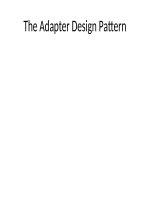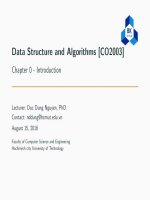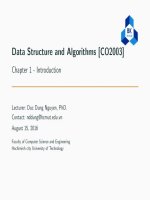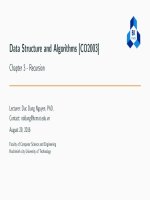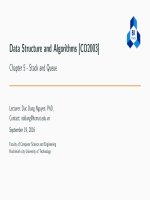C++ programming program design including data structure 7th ch12
Bạn đang xem bản rút gọn của tài liệu. Xem và tải ngay bản đầy đủ của tài liệu tại đây (511.12 KB, 46 trang )
Chapter 12:
Pointers, Classes, Virtual
Functions, Abstract Classes, and
Lists
Objectives
• In this chapter, you will:
– Learn about the pointer data type and pointer variables
– Explore how to declare and manipulate pointer variables
– Learn about the address of operator and the dereferencing
operator
– Learn how pointers work with classes and structs
– Discover dynamic variables
C++ Programming: Program Design Including Data Structures, Seventh Edition
2
Objectives (cont’d.)
– Explore how to use the new and delete operators to
manipulate dynamic variables
– Learn about pointer arithmetic
– Learn how to work with dynamic arrays
– Become familiar with the limitations of range-based for
loops with dynamic arrays
– Explore how pointers work with functions as parameters
and functions as return values
C++ Programming: Program Design Including Data Structures, Seventh Edition
3
Objectives (cont’d.)
– Become familiar with shallow and deep copies
– Discover the peculiarities of classes with pointer member
variables
– Learn about virtual functions
– Become aware of abstract classes
– Learn about array based lists and the basic operations on
them
– Examine the relationship between the address of operator
and classes
C++ Programming: Program Design Including Data Structures, Seventh Edition
4
Pointer Data Type and Pointer
Variables
• Pointer variable: content is a memory address
• No name associated with the pointer data type in C+
+
C++ Programming: Program Design Including Data Structures, Seventh Edition
5
Declaring Pointer Variables
• Syntax:
• Examples:
int *p;
char *ch;
• These statements are equivalent:
int *p;
int* p;
int * p;
C++ Programming: Program Design Including Data Structures, Seventh Edition
6
Declaring Pointer Variables (cont’d.)
• In the statement:
int* p, q;
– Only p is a pointer variable
– q is an int variable
• To avoid confusion, attach the character * to the
variable name:
int *p, q;
int *p, *q;
C++ Programming: Program Design Including Data Structures, Seventh Edition
7
Address of Operator (&)
• Address of operator (&):
– A unary operator that returns the address of its operand
• Example:
int x;
int *p;
p = &x;
– Assigns the address of x to p
C++ Programming: Program Design Including Data Structures, Seventh Edition
8
Dereferencing Operator (*)
• Dereferencing operator (or indirection operator):
– When used as a unary operator, * refers to object to which
its operand points
• Example:
cout << *p << endl;
– Prints the value stored in the memory location pointed to
by p
C++ Programming: Program Design Including Data Structures, Seventh Edition
9
Classes, structs, and Pointer
Variables
• You can declare pointers to other data types:
– student is an object of type studentType
– studentPtr is a pointer variable of type
studentType
C++ Programming: Program Design Including Data Structures, Seventh Edition
10
Classes, structs, and Pointer
Variables (cont’d.)
• To store address of student in studentPtr:
studentPtr = &student;
• To store 3.9 in component gpa of student:
(*studentPtr).gpa = 3.9;
– ( ) used because dot operator has higher precedence than
dereferencing operator
– Alternative: use member access operator arrow (->)
C++ Programming: Program Design Including Data Structures, Seventh Edition
11
Classes, structs, and Pointer
Variables (cont’d.)
• Syntax to access a class (struct) member using
the operator -> :
• Thus,
(*studentPtr).gpa = 3.9;
is equivalent to:
studentPtr->gpa = 3.9;
C++ Programming: Program Design Including Data Structures, Seventh Edition
12
Initializing Pointer Variables
• C++ does not automatically initialize variables
• Pointer variables must be initialized if you do not
want them to point to anything
– Initialized using the null pointer: the value 0
– Or, use the NULL named constant
– The number 0 is the only number that can be directly
assigned to a pointer variable
• C++11 includes a nullptr
C++ Programming: Program Design Including Data Structures, Seventh Edition
13
Dynamic Variables
• Dynamic variables: created during execution
• C++ creates dynamic variables using pointers
• new and delete operators: used to create and
destroy dynamic variables
– new and delete are reserved words in C++
C++ Programming: Program Design Including Data Structures, Seventh Edition
14
Operator new
• new has two forms:
– intExp is any expression evaluating to a positive integer
• new allocates memory (a variable) of the designated
type and returns a pointer to it
– The allocated memory is uninitialized
C++ Programming: Program Design Including Data Structures, Seventh Edition
15
Operator new (cont’d.)
• Example: p = new int;
– Creates a variable during program execution somewhere in
memory
– Stores the address of the allocated memory in p
• To access allocated memory, use *p
• A dynamic variable cannot be accessed directly
• Because it is unnamed
C++ Programming: Program Design Including Data Structures, Seventh Edition
16
Operator delete
• Memory leak: previously allocated memory that
cannot be reallocated
– To avoid a memory leak, when a dynamic variable is no
longer needed, destroy it to deallocate its memory
• delete operator: used to destroy dynamic variables
• Syntax:
C++ Programming: Program Design Including Data Structures, Seventh Edition
17
Operations on Pointer Variables
• Assignment: value of one pointer variable can be
assigned to another pointer of same type
• Relational operations: two pointer variables of same
type can be compared for equality, etc.
• Some limited arithmetic operations:
– Integer values can be added and subtracted from a pointer
variable
– Value of one pointer variable can be subtracted from
another pointer variable
C++ Programming: Program Design Including Data Structures, Seventh Edition
18
Operations on Pointer Variables
(cont’d.)
• Pointer arithmetic can be very dangerous:
– Program can accidentally access memory locations of other
variables and change their content without warning
• Some systems might terminate the program with an
appropriate error message
• Always exercise extra care when doing pointer
arithmetic
C++ Programming: Program Design Including Data Structures, Seventh Edition
19
Dynamic Arrays
• Dynamic array: array created during program
execution
• Example:
int *p;
p = new int[10];
*p = 25;
stores 25 into the first memory location
p++; //to point to next array component
stores 35 into the second memory location
*p = 35;
C++ Programming: Program Design Including Data Structures, Seventh Edition
20
Dynamic Arrays (cont’d.)
• Can use array notation to access these memory
locations
• Example:
p[0] = 25;
p[1] = 35;
– Stores 25 and 35 into the first and second array
components, respectively
• An array name is a constant pointer
C++ Programming: Program Design Including Data Structures, Seventh Edition
21
Functions and Pointers
• Pointer variable can be passed as a parameter either
by value or by reference
• As a reference parameter in a function heading, use
&:
void pointerParameters(int* &p, double *q)
{
. . .
}
C++ Programming: Program Design Including Data Structures, Seventh Edition
22
Pointers and Function Return Values
• A function can return a value of type pointer:
int* testExp(...)
{
. . .
}
C++ Programming: Program Design Including Data Structures, Seventh Edition
23
Dynamic Two-Dimensional Arrays
• You can create dynamic multidimensional arrays
• Examples:
declares board to be an array of four
pointers wherein each pointer is of type int
creates the rows of board
declares board to be a pointer to a pointer
C++ Programming: Program Design Including Data Structures, Seventh Edition
24
Shallow Versus Deep Copy and
Pointers
• Shallow copy: when two or more pointers of the
same types point to the same memory
– They point to the same data
– Danger: deleting one deletes the data pointed to by all of
them
• Deep copy: when the contents of the memory
pointed to by a pointer are copied to the memory
location of another pointer
– Two copies of the data
C++ Programming: Program Design Including Data Structures, Seventh Edition
25

